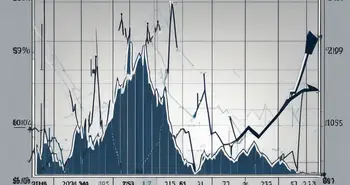What Makes Exchange-Traded Funds (ETFs) Unique in the Market?

Exchange-Traded Funds (ETFs) have revolutionized the way investors buy and sell securities. Their unique features set them apart from traditional investment vehicles like mutual funds and stocks. In this article, I will provide an in-depth analysis of what makes ETFs stand out in the market and explain why they have become increasingly popular among both individual and institutional investors.
Understanding the Basics of Exchange-Traded Funds
Exchange-Traded Funds (ETFs) have become increasingly popular investment vehicles in recent years. They offer investors a unique combination of flexibility, diversification, and transparency. In this article, we will delve deeper into the world of ETFs, exploring their structure, types, and benefits.
Defining Exchange-Traded Funds (ETFs)
Let's begin by defining what exactly ETFs are. Put simply, an ETF is a type of investment fund that is traded on stock exchanges, making it readily available for investors to buy and sell throughout the trading day. ETFs are designed to track the performance of a specific index, commodity, sector, or asset class.
ETFs provide investors with an opportunity to gain exposure to a diversified portfolio of assets without having to buy each individual security. This makes them an attractive option for both individual and institutional investors looking to achieve broad market exposure.
The Structure of ETFs
ETFs are structured in a way that provides investors with the benefits of both mutual funds and stocks. Similar to mutual funds, ETFs are managed by professional portfolio managers who oversee the fund's investments. However, unlike mutual funds, which are bought and sold at the end of the trading day at their net asset value (NAV), ETFs can be traded like individual stocks at market prices throughout the day.
This intraday trading feature of ETFs allows investors to take advantage of market fluctuations and execute trades at their desired price levels. It also provides investors with the ability to implement various trading strategies, such as day trading or short selling, which are not typically available with traditional mutual funds.
Different Types of ETFs
There is a wide variety of ETFs available in the market today, catering to different investment objectives and strategies. Some ETFs aim to replicate the performance of a specific stock index, such as the S&P 500, while others focus on specific sectors, such as technology or healthcare. Additionally, investors can find ETFs that provide exposure to commodities, bonds, currencies, and even alternative assets like real estate investment trusts (REITs).
One of the key advantages of ETFs is their ability to offer investors exposure to niche markets or specific investment themes. For example, there are ETFs that focus on renewable energy companies, artificial intelligence, or emerging markets. This allows investors to align their investment portfolios with their personal beliefs or capitalize on emerging trends in the global economy.
Furthermore, ETFs can be categorized based on their investment strategies. Some ETFs follow a passive investment approach, aiming to replicate the performance of a specific index. These are known as index ETFs. On the other hand, there are actively managed ETFs, where the portfolio manager actively selects and manages the underlying securities in an attempt to outperform the market.
Overall, ETFs have revolutionized the way investors approach the financial markets. They offer a cost-effective, transparent, and flexible investment solution that can be tailored to individual investment objectives. Whether you are a seasoned investor or just starting out, understanding the basics of ETFs is essential for building a well-diversified and efficient investment portfolio.
The Unique Features of ETFs
Flexibility in Trading
One of the key advantages of ETFs is their flexibility in trading. Unlike mutual funds, ETFs can be bought or sold anytime during market hours. This allows investors to react quickly to market trends or take advantage of intraday price movements.
For example, let's say an investor notices a sudden surge in the price of a particular sector ETF due to positive news about the industry. With the flexibility of ETF trading, the investor can quickly buy shares of the ETF to capitalize on the upward momentum, potentially maximizing their returns.
Moreover, ETFs offer the ability to place limit orders, stop orders, and other advanced trading strategies that are commonly used with stocks. This provides investors with greater control over their trades and allows them to implement specific trading strategies to achieve their investment goals.
Tax Efficiency of ETFs
ETFs are often considered more tax-efficient than mutual funds. This is due to the unique structure of ETFs, which allows for in-kind creations and redemptions of shares.
When an authorized participant wants to create or redeem ETF shares, they can do so by exchanging a basket of underlying securities rather than cash. This process helps to minimize taxable capital gains distributions, resulting in potential tax savings for investors.
For instance, imagine an investor holds shares of an ETF that has experienced significant capital gains. Instead of selling the shares and triggering a taxable event, the investor can redeem the shares in-kind, avoiding immediate tax consequences. This tax-efficient feature of ETFs can be particularly beneficial for long-term investors looking to minimize their tax liabilities.
Transparency in ETFs
ETFs offer a high level of transparency to investors. Since ETFs are designed to track specific indices or assets, the fund holdings are usually disclosed on a daily basis.
This transparency allows investors to have a clear view of the underlying securities held within the ETF. By knowing the exact composition of the fund, investors can make informed investment decisions and better manage portfolio risk.
For example, suppose an investor is interested in investing in a socially responsible ETF that claims to focus on environmentally friendly companies. By reviewing the daily disclosed holdings, the investor can verify if the ETF indeed holds stocks of companies that align with their values and sustainability goals.
Furthermore, transparency in ETFs enables investors to monitor the performance and potential risks associated with the underlying assets. This information empowers investors to adjust their investment strategies accordingly and maintain a well-diversified portfolio.
Comparing ETFs with Other Investment Vehicles
When it comes to investing, there are various options available to individuals seeking to grow their wealth. Two popular investment vehicles are exchange-traded funds (ETFs) and mutual funds. Let's take a closer look at how these two options compare.
ETFs vs Mutual Funds
ETFs provide investors with more trading flexibility compared to mutual funds. Unlike mutual funds, which are priced at the end of the trading day, ETFs can be bought and sold throughout the day, just like individual stocks. This flexibility allows investors to take advantage of market movements and adjust their positions accordingly.
Another advantage of ETFs over mutual funds is their lower expense ratios. Expense ratios represent the annual fees charged by the fund provider to cover operational costs. ETFs tend to have lower expense ratios compared to mutual funds, which means investors can keep a larger portion of their investment returns.
Furthermore, ETFs offer potential tax advantages. Mutual funds are subject to capital gains distributions, which occur when the fund manager sells securities within the fund, resulting in taxable gains for investors. In contrast, ETFs are structured in a way that minimizes capital gains distributions, potentially reducing the tax burden for investors.
ETFs vs Stocks
While both ETFs and stocks are traded on stock exchanges, they serve different investment purposes. Stocks represent ownership in a single company, allowing investors to participate in the company's growth and profitability. On the other hand, ETFs offer diversified exposure to a basket of securities, such as stocks, bonds, or commodities.
One of the main advantages of ETFs is their ability to provide instant diversification. By investing in an ETF, investors gain exposure to a wide range of securities, which helps spread the risk across different assets. This diversification can be particularly beneficial for those looking to mitigate the impact of a single stock's performance on their overall investment portfolio.
Additionally, ETFs are a suitable choice for those looking to invest in specific sectors, asset classes, or indices without relying on the performance of a single stock. For example, an investor interested in the technology sector can invest in a technology-focused ETF, which provides exposure to multiple technology companies, rather than investing in a single tech stock.
ETFs vs Index Funds
ETFs and index funds are similar in that they both aim to track the performance of a specific index. An index represents a specific market or sector and serves as a benchmark for measuring the performance of a group of securities. However, there are some key differences between ETFs and index funds.
One major advantage of ETFs over index funds is their intraday trading capability. ETFs can be bought and sold throughout the trading day, allowing investors to react quickly to market movements and adjust their positions accordingly. In contrast, index funds can only be bought or sold at the end of the trading day, at the net asset value (NAV) price.
Additionally, ETFs may offer lower expense ratios compared to index funds. This is because ETFs are passively managed, meaning they aim to replicate the performance of an index rather than actively selecting and managing securities. As a result, the operational costs associated with ETFs tend to be lower, leading to lower expense ratios for investors.
Overall, when considering different investment vehicles, it's important to assess your investment goals, risk tolerance, and time horizon. ETFs offer unique advantages such as trading flexibility, lower expense ratios, and potential tax advantages. However, each investment vehicle has its own characteristics and suitability for different investors. It's always recommended to consult with a financial advisor or do thorough research before making any investment decisions.
The Role of ETFs in Portfolio Diversification
Broad Market Exposure with ETFs
ETFs provide investors with an efficient way to achieve broad market exposure. By investing in ETFs that track well-diversified indices, such as the S&P 500, investors can gain exposure to a wide range of stocks across various industries and sectors. This broad diversification helps to reduce the risk associated with investing in individual stocks.
Investing in a single stock can be risky, as the performance of that stock is dependent on the success of the underlying company. However, by investing in an ETF that tracks a broad market index, investors can spread their risk across multiple companies. This means that even if one company in the index performs poorly, the overall impact on the investor's portfolio is minimized.
Furthermore, ETFs offer the advantage of liquidity. Unlike mutual funds, which are priced at the end of the trading day, ETFs can be bought and sold throughout the trading day at market prices. This allows investors to react quickly to market movements and make adjustments to their portfolio as needed.
Sector-Specific ETFs for Targeted Investment
For investors who wish to concentrate their investments in specific sectors, ETFs offer a convenient solution. Sector-specific ETFs allow investors to target industries such as technology, healthcare, or energy, providing exposure to companies within those sectors. This can be particularly useful for investors who want to align their portfolio with their knowledge or expectations of certain industries.
By investing in sector-specific ETFs, investors can take advantage of the growth potential of specific industries. For example, if an investor believes that renewable energy will be a major driver of economic growth in the future, they can allocate a portion of their portfolio to a renewable energy ETF. This allows them to participate in the potential upside of the industry without having to pick individual stocks.
Additionally, sector-specific ETFs can help investors diversify their portfolios beyond the broad market. By investing in sectors that are not well-represented in the broad market index, investors can further reduce their exposure to specific risks. This can be particularly beneficial in times of economic uncertainty, as different sectors may perform differently in response to changing market conditions.
As an expert in the field, I have seen firsthand the advantages ETFs bring to investors' portfolios. Take, for example, a recent client of mine who was looking to diversify his retirement savings. After carefully assessing his risk tolerance and investment goals, I recommended a combination of broad market ETFs and sector-specific ETFs to achieve the desired level of diversification and exposure to specific sectors he believed would experience significant growth in the coming years.
By allocating a portion of his portfolio to low-cost S&P 500 ETFs, he was able to gain broad exposure to the U.S. stock market. Simultaneously, he invested in sector-specific ETFs targeting renewable energy and technology, aligning his investments with his beliefs in the future growth potential of these industries.
Not only did this allocation provide him with diversified exposure to the market, it also allowed him to capitalize on the potential of specific sectors. Over time, this strategic investment approach paid off, and his retirement portfolio experienced consistent growth.
In conclusion, exchange-traded funds (ETFs) offer unique features that set them apart in the market. Their flexibility in trading, tax efficiency, and transparency make them an attractive option for investors seeking diversification and exposure to specific sectors. Whether you are a seasoned investor or just starting out, incorporating ETFs into your investment strategy can be a wise decision that sets you on a path towards financial success.
As you consider the potential of stock trading and the broader cryptocurrency landscape, why not expand your investment horizon with Morpher? At Morpher.com, you can leverage the power of blockchain technology to trade across a multitude of asset classes, including cryptocurrencies, without the burden of fees or liquidity constraints. With the ability to engage in fractional investing, short selling, and up to 10x leverage, Morpher offers a unique and flexible trading experience that aligns perfectly with the innovative spirit of crypto mining. Take control of your investments with the safety of the Morpher Wallet and explore new market opportunities today. Sign Up and Get Your Free Sign Up Bonus to embark on a transformative trading journey with Morpher.

Disclaimer: All investments involve risk, and the past performance of a security, industry, sector, market, financial product, trading strategy, or individual’s trading does not guarantee future results or returns. Investors are fully responsible for any investment decisions they make. Such decisions should be based solely on an evaluation of their financial circumstances, investment objectives, risk tolerance, and liquidity needs. This post does not constitute investment advice.

Painless trading for everyone
Hundreds of markets all in one place - Apple, Bitcoin, Gold, Watches, NFTs, Sneakers and so much more.

Painless trading for everyone
Hundreds of markets all in one place - Apple, Bitcoin, Gold, Watches, NFTs, Sneakers and so much more.








